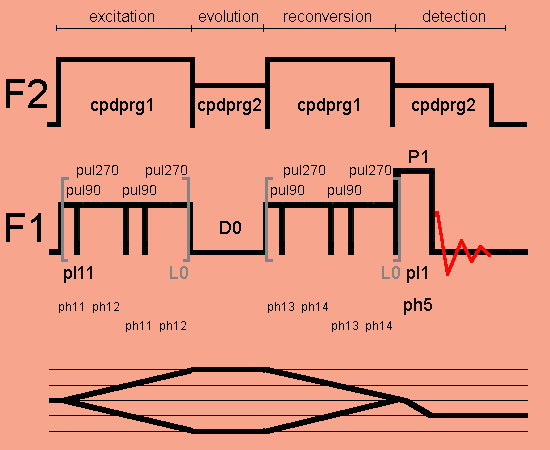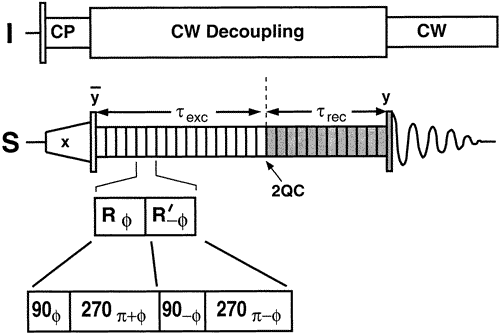
R14_2^6hp-2d: 2D double quantum excitation R1426 HP decoupling pulse program (TopSpin2.1)

Since non-phase cycling is applied to the R14_2^6 excitation pulse, four-phase cycling is applied to the detection pulse P1 for selecting the 0Q -> -1Q coherence order jump, and four-phase cycling is applied to the R14_2^6 reconversion pulse for filtering DQ coherences.
;r14-2-6hp_2d (TopSpin 2.0) ;2D SQ-DQ correlation experiment with R14_2^6, use r14-2-6_1d for setup ;M. Carravetta, M. Eden, X. Zhao, A. Brinkmann and M.H. Levitt, ;Symmetry principles for the design of radiofrequency pulse seqeunces in ;the nuclear magnetic resonance of rotating solids, Chem. Phys. Lett 321 (2000) 205-215 ;by JOS 02/28/03 ;Avance II+ version ;parameters: ;d1 : recycle delay ;d0 : incremented delay (2D) [3 usec] ;p1 : excitation pulse at pl1 ;pcpd2 : pulse length in decoupling sequence ;cpdprg1 : decoupling pulseprogram during recoupling, cw or cwlg ;cpdprg2 : decoupling pulseprogram, pidec12 or tppm15 ;pl1 : f1 power level ;pl11 : for R14_2^6 recoupling sequence B1=7*cnst31 in Hz ;pl12 : for decoupling ;pl13 : for decoupling during recoupling ;cnst20 : LG-RF field as adjusted, in Hz used to calculate cnst22 and cnst23 +and - LG frequency ;cnst21 : =0 frequency reset on resonance (set by lgclac.incl) ;cnst22 : +LG frequency offset calc. by lgcalc.incl ;cnst23 : -LG frequency offset calc. by lgcalc.incl ;cnst24 : additional offset for 1H LG offset ;cnst31 : spinning speed ;l0 : 2*number of composite R14_2^6 cycles (pul90 + pul270) for DQ excitation ;l3 : for t1 increment ;in0: l3*rotorperiod, t1 increment ;ns : n*16 ;FnMode : undefined ;mc2 : STATES-TPPI ;nd0 : 1 ;$COMMENT=SQ-DQ experiment with R14_2^6 and decoupling ;$CLASS=Solids ;$DIM=2D ;$TYPE=direct excitation ;$SUBTYPE=homonuclear correlation ;$OWNER=Bruker define loopcounter count ;for STATES-TPPI procedure "count=td1/2" ;and STATES cos/sin procedure define pulse pul90 "pul90=(1.0s/cnst31)/28" define pulse pul270 "pul270=((3.0s/cnst31)/28)" "d31=1s/cnst31" "d0=1u" "in0=l3*d31" ;cnst11 : to adjust t=0 for acquisition, if digmod = baseopt "acqt0=1u*cnst11" #include <rot_prot.incl> ze ;acquire into a cleared memory 1 d31 2 d1 do:f2 ;recycle delay, F2 decoupler off 1m rpp11 ;reset the phase ph11 pointer to the first element 1m rpp12 ;reset the phase ph12 pointer to the first element 1m rpp13 ;reset the phase ph13 pointer to the first element 1m rpp14 ;reset the phase ph14 pointer to the first element 10u reset:f1 1u fq=cnst21:f2 1u pl11:f1 cpds1:f2 ;switch to R14_2^6 RF condition ;F2 decoupling during R14_2^6 excitation ;R14_2^6 DQ excitation 3 (pul90 ph11 ipp11):f1 ;increment phase ph11 pointer (pul270 ph12 ipp12):f1 ;increment phase ph12 pointer (pul90 ph11 ipp11):f1 ;increment phase ph11 pointer (pul270 ph12 ipp12):f1 ;increment phase ph12 pointer lo to 3 times l0 ;l0 = multiple of 7 ;DQ evolution: 0.1u do:f2 ;F2 decoupler off d0 cpds2:f2 ;F2 decoupling during DQ evolution 0.1u do:f2 ;F2 decoupler off 0.1u cpds1:f2 ;F2 decoupling during R14_2^6 reconversion ;R14_2^6 DQ reconversion 4 (pul90 ph13 ipp13):f1 ;increment phase ph13 pointer (pul270 ph14 ipp14):f1 ;increment phase ph14 pointer (pul90 ph13 ipp13):f1 ;increment phase ph13 pointer (pul270 ph14 ipp14):f1 ;increment phase ph14 pointer lo to 4 times l0 ;l0 = multiple of 7 0.1u do:f2 ;F2 decoupler off (p1 pl1 ph5):f1 ;detection pulse 1u cpds2:f2 ;F2 decoupling during acquisition gosc ph31 ;gosc does not loop to 1 ;DQ filtering (four phase cycling): 1m ip13*16384 ;increments all phases of ph13 by 90° 1m ip14*16384 ;increments all phases of ph14 by 90° 1m do:f2 ;F2 decoupler off lo to 1 times ns ;next scan 10u do:f2 ;F2 decoupler off 100m wr #0 if #0 zd ;save data 1m ip11*8192 ;increments all phases of ph11 by 45°, ;90° phase for DQ coherence 1m ip12*8192 ;increments all phases of ph12 by 45°, ;90° phase for DQ coherence lo to 1 times 2 ;t1 quadrature detection 1m id0 ;increment in l3*Tr ;1m rp11 ;reset all phases of ph11, ph12, ph13, and ph14 ;1m rp12 ;to their original values, i.e. to the values they ;1m rp13 ;had before the first ip11, ip12, ip13, and ip14 ;1m rp14 ;in case of STATES remove semicolon at beginning of the 4 lines lo to 1 times count ;count=td1/2 10u do:f2 ;F2 decoupler off HaltAcqu, 1m exit ph11=(65536) 14043 51493 ; 77.14° 282.86° or 77.14° -77.14° ph12=(65536) 46811 18725 ;257.14° 102.86° or 77.14°+180° -77.14°+180° ph13=(65536) 30427 2341 ;ph11 + 90° ph14=(65536) 63195 35109 ;ph12 + 90° ph5= 0 0 0 0 2 2 2 2 1 1 1 1 3 3 3 3 ph31=0 2 0 2 2 0 2 0 1 3 1 3 3 1 3 1

Definition of R1426 excitation pulse.